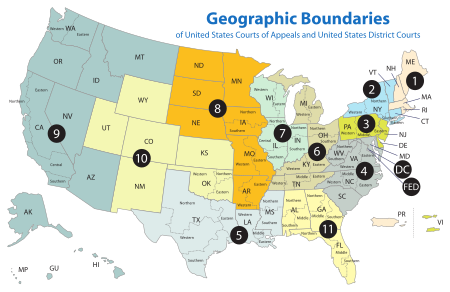U.S. Courts of Appeals
The U.S. Courts of Appeals are the 13 intermediate appellate courts in the three-tiered U.S. federal judiciary. These courts are between the Supreme Court of the United States and the United States District Courts. The federal court system emerged due to Article III, section 1, of the United States Constitution, which addresses the judicial power of the United States and places it in the United States Supreme Court and "such inferior courts" as the Congress may create through legislation.
The U.S. Courts of Appeals are also sometimes referred to as U.S. Circuit Courts. The district covered by a U.S. Court of Appeals is called a "circuit" because, at one time, judges actually traveled around the district to hear cases. So someone might say "Ninth Circuit Court" to refer to the U.S. Court of Appeals for the Ninth Circuit.
The United States Courts of Appeals consist of fourteen individual courts: thirteen defined by geography and one by jurisdiction. These courts are the regional courts numbered the First through Twelfth Circuits and the District of Columbia Circuit. The Federal Circuit is defined by its jurisdiction created in 1982 out of the then existing Court of Claims and the Court of Customs and Patent Appeals.
The Courts of Appeals were created by the Circuit Courts of Appeals Act in 1891. These courts were created in reaction to the lack of institutional capacity in the existing federal judiciary which had not been significantly changed since the enactment of the Judiciary Act of 1789.
The Courts of Appeals
- U.S. Court of Appeals for the First Circuit: The U.S. Court of Appeals for ME, MA, NH, Puerto Rico and RI, located in Boston, Massachusetts. [e]
- U.S. Court of Appeals for the Second Circuit: The U.S. Court of Appeals for CT, NY and VT, located in New York City. [e]
- U.S. Court of Appeals for the Third Circuit: The U.S. Court of Appeals for DE, NJ and PA, located in Philadelphia. [e]
 U.S. Court of Appeals for the Fourth Circuit: The U.S. Court of Appeals for DE, MD, NC, SC, VA, and WV, located in Richmond. [e]
U.S. Court of Appeals for the Fourth Circuit: The U.S. Court of Appeals for DE, MD, NC, SC, VA, and WV, located in Richmond. [e]- U.S. Court of Appeals for the Fifth Circuit: The U.S. Court of Appeals for LA, MS and TX, located in New Orleans. [e]
- U.S. Court of Appeals for the Sixth Circuit: The U.S. Court of Appeals for KY, MI, OH, and TN, located in Cincinnati. [e]
- U.S. Court of Appeals for the Seventh Circuit: The U.S. Court of Appeals for IL, IN and WI, located in Chicago. [e]
 U.S. Court of Appeals for the Eighth Circuit: The U.S. Court of Appeals for AR, IO, MN, MI, NE, ND and SD, located in St. Louis. [e]
U.S. Court of Appeals for the Eighth Circuit: The U.S. Court of Appeals for AR, IO, MN, MI, NE, ND and SD, located in St. Louis. [e] U.S. Court of Appeals for the Ninth Circuit: The U.S. Court of Appeals for AK, AZ, CA, HI, ID, NV, OR, and WA, located in San Francisco. [e]
U.S. Court of Appeals for the Ninth Circuit: The U.S. Court of Appeals for AK, AZ, CA, HI, ID, NV, OR, and WA, located in San Francisco. [e] U.S. Court of Appeals for the Tenth Circuit: The U.S. Court of Appeals for CO, KA, NM, OK, UT, and WY, located in Denver. [e]
U.S. Court of Appeals for the Tenth Circuit: The U.S. Court of Appeals for CO, KA, NM, OK, UT, and WY, located in Denver. [e]- U.S. Court of Appeals for the Eleventh Circuit: The U.S. Court of Appeals for AL, FL and GA, located in Atlanta. [e]
- U.S. Court of Appeals for the District of Columbia Circuit: Add brief definition or description
- U.S. Court of Appeals for the Federal Circuit: Add brief definition or description
